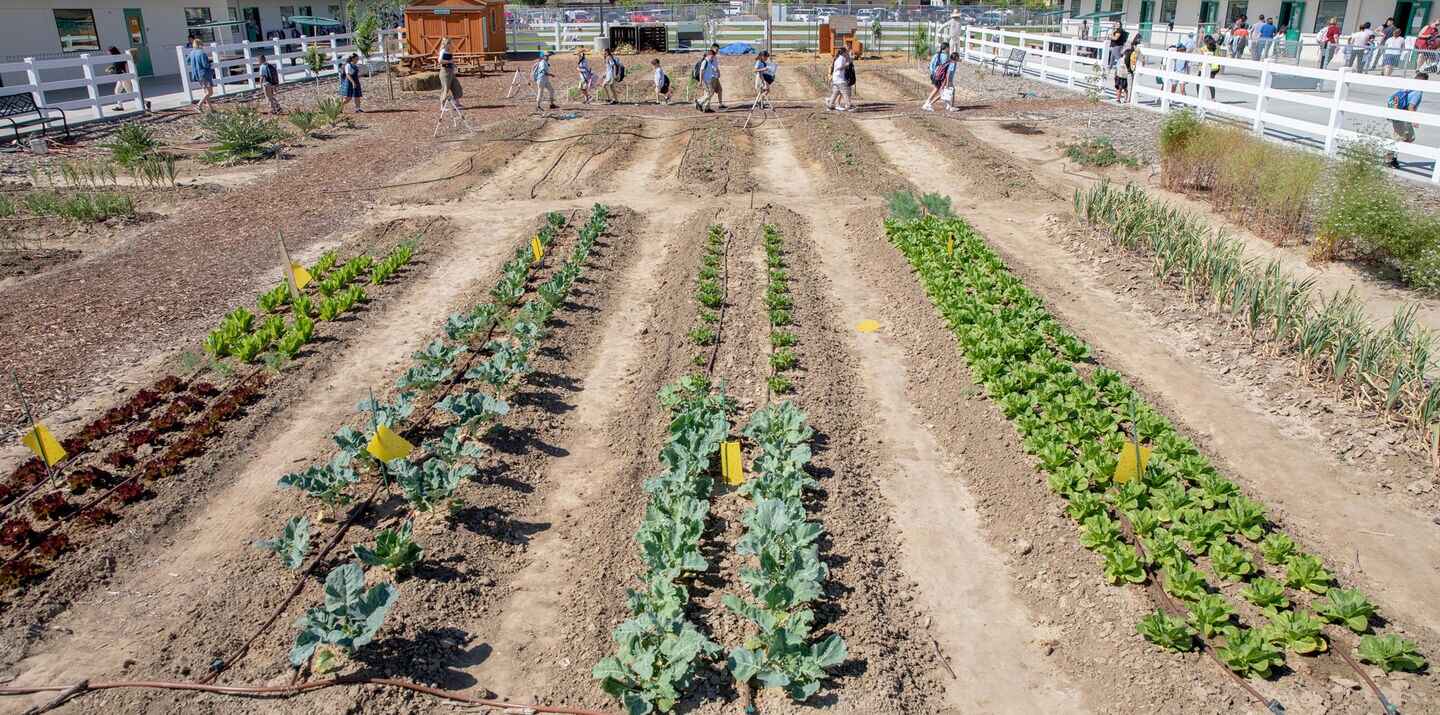
In a California Farming Community, Students Grow More than Lettuce
In the heart of California’s farmlands, students tend a school garden and cook healthy dishes while their principal considers the future of her home region.
This acreage in the sun-blasted, California Central Valley town of Shafter (population 19,000) used to be an almond orchard. Today, what stands here is an elementary school, almost two years old.
The classroom wings, walkways, and play fields were built around a central garden that is planted, cultivated, and irrigated by about 540 students and 3 garden teachers.
“We put the garden in the middle of the school because it’s at the heart of everything we do,” said Joanna Kendrick (L.A. ’05), the founding principal of the wellness-themed Grimmway Academy.
There’s a “café” here where every student and teacher eats a free, scratch-cooked, low-sugar and low-sodium lunch, complete with milk from a dispenser (no throw-away cartons). One recent Wednesday, students tucked into Mongolian beef cooked with rice wine, fresh ginger, and chiles and garlic from the garden.
Next to the café is a big, yellow-painted, cement-floored kitchen lab where three culinary teachers, trained by the Berkeley-based Edible Schoolyard, lead students in cooking (and eating) what they grow, and what they gather from their chickens.
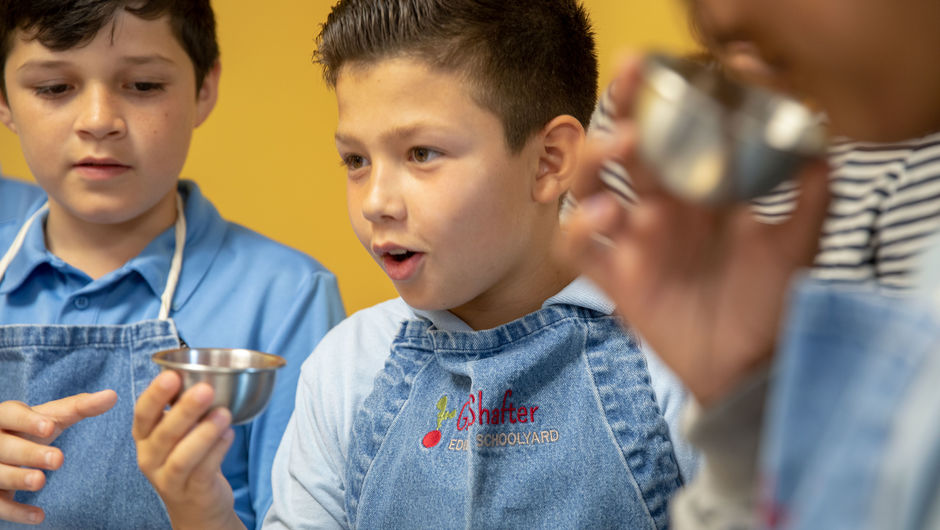
This second year is critical for the school, which promises to put kids on a college trajectory in a farm-based community where most adults don’t have degrees but want them for their children. Last year, as the school established its culture and unconventional curriculum, some 90% of students hit targets for growth. This year, the target is higher achievement.
Principal Kendrick grew up nearby in Bakersfield. She is risking that, with a longer school day and year, she can offer less time in the day for core academics than at other schools she has led, and more for movement, mood checks and mindfulness, cooking, and electives like stringed instrument lessons.
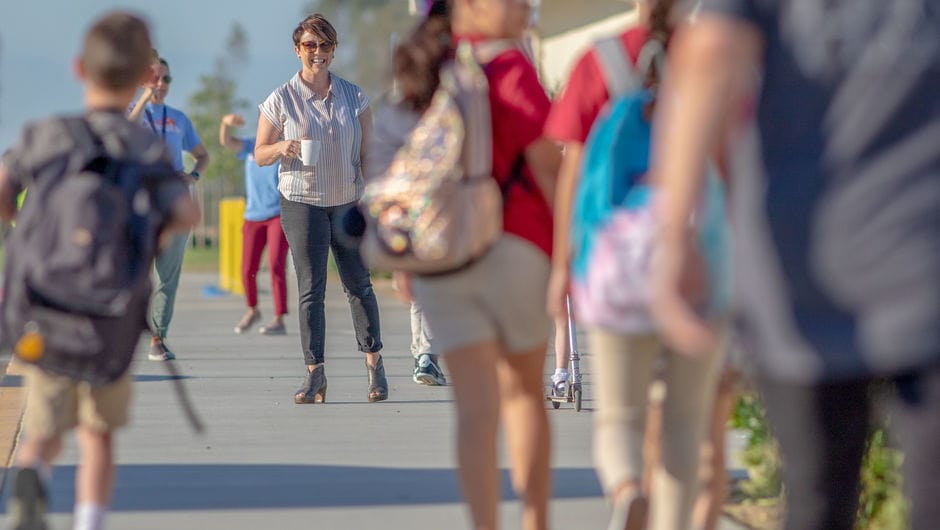
School goes year-round with a summer break of about a month. Fall and spring breaks are scheduled to coincide with times when many families travel to Sinaloa or Guanajuato, Mexico, for reunions and celebrations.
The day goes from when the library opens at 7:15 until 3:40, with a free after-school program until 6 p.m. Every student goes to an elective and a rambunctious recess with coaches playing dance mixes and overseeing soccer and lacrosse games. “We have so many things that we need to get better at,” says Kendrick, seen here at morning drop-off, “but I’ve never seen students happier at a school.”
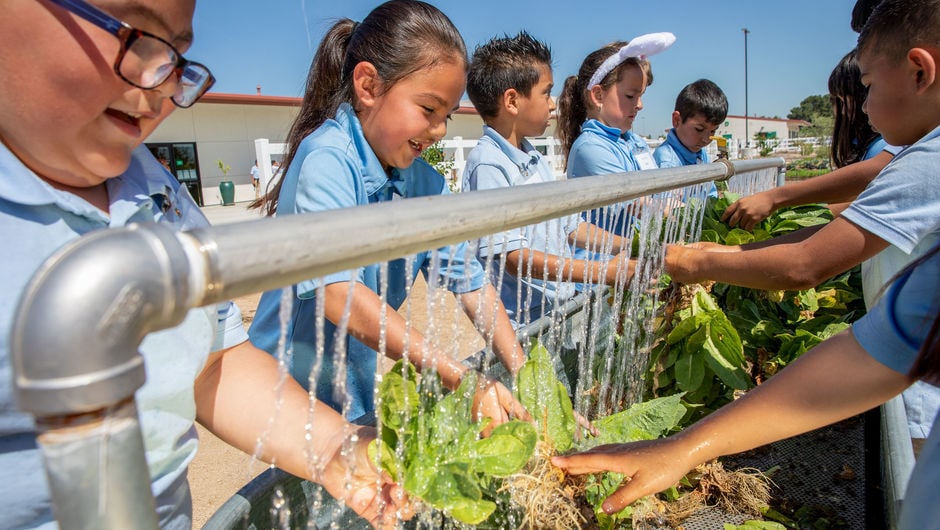
For one week out of every four, students spend five 75-minute periods learning in the garden. Another full week is spent in the food lab. It’s hot in the garden. Kids gather at the start of each lesson in the shade of the ramada. They might be discussing biology or entomology. The curriculum includes 15 lessons on composting alone.
What students like best is getting into the dirt. First graders washed the soil off lettuce and carrots they pulled for students who were making rosemary hummus in the lab.

Every Friday the garden and kitchen teachers take a “chef’s tour” to plan recipes around what to harvest now. This week was the last for romaine. “Lettuce is a Kern County crop,” garden teacher Garrett Pierce had told first graders, “but we can only grow it in the cooler months.”
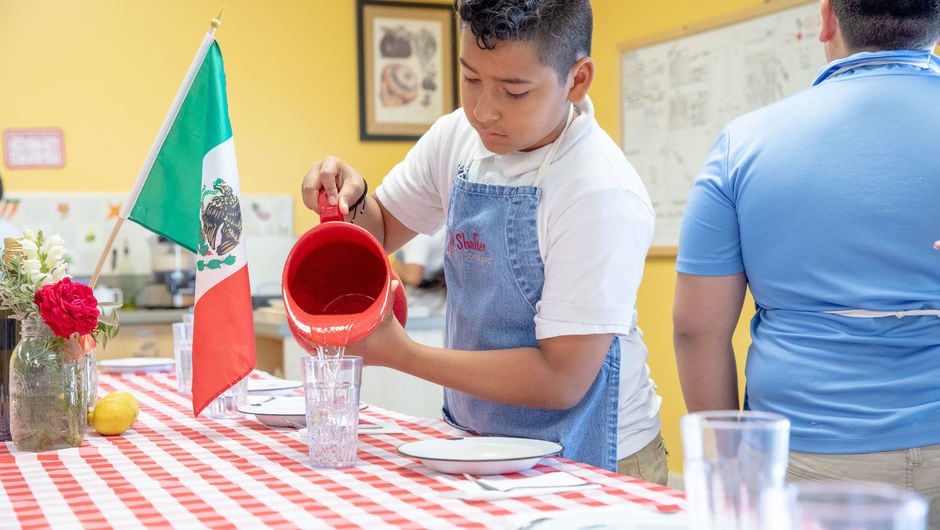
In the food lab, students cook a recipe from start to finish, eat family style at a table they set with flowers from the garden, and compost their leftovers. They use real chef’s knives (with finger guards), cook on real burners, and decide together how aggressively to spice dishes. Recipes go home with students. Fifth graders keep the peach salsa in heavy rotation. Six times a year, parents are invited to cook with their kids.
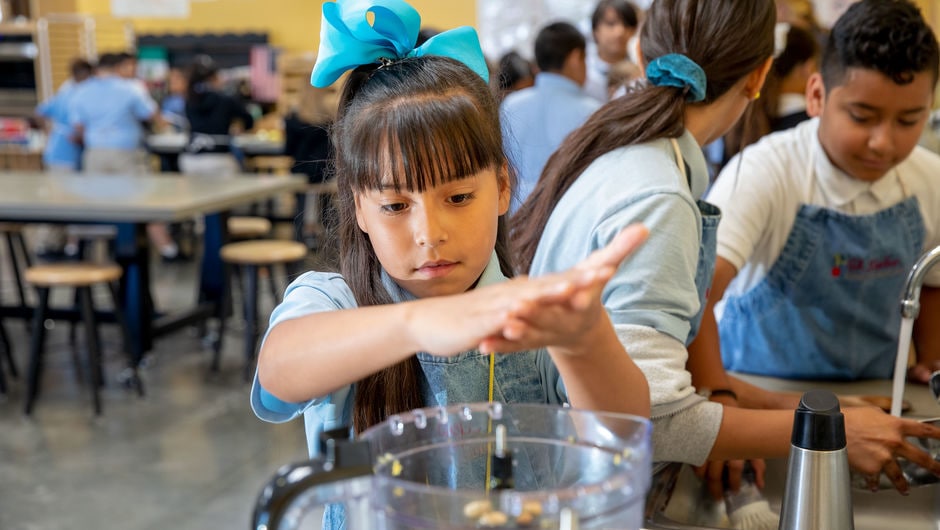
As first graders tore chard leaves and snipped herbs for an orzo salad, teacher Molly Sowers told them, “Bitter greens are like scrub brushes for your tummies.” Fifth graders handled kitchen tools, including food processors, like pros.
Teachers can’t bring any off-campus food to school or drink from branded paper coffee cups. “Fine with me, the café food is delicious,” teacher Ana Kittridge said, as she scrolled through her photo gallery of favorite Grimmway lunches. “And it’s made me more accountable for what I eat at home.”

If students embrace the garden, some parents question it. Many are first, second, or third generation farmworkers. Community members asked for a school that is safe, caring, and academically sound. They got that, plus a health-themed curriculum that they did not request. One Day reporters talked to parents who embrace the curriculum and others who keep their kids here in spite of it. Kendrick has been quizzed: Why is my child picking lettuce? Some parents who make their living in oil fields or from not-so-sustainable agri-business have expressed skepticism about the environmental aspects of the school.
“We talk about how the valley is changing,” Kendrick says. Farming depends less on labor and more on automation. Water is running out. Teaching students to sustain and protect the living environment is mission-critical, and so is offering an education that prepares them to start home-grown ventures that don’t depend on agri-business or oil extraction, she says.
School staff members, many of them local to Shafter, are still figuring out with parents how to make the Edible Schoolyards curriculum, and the school in general, more culturally relevant.
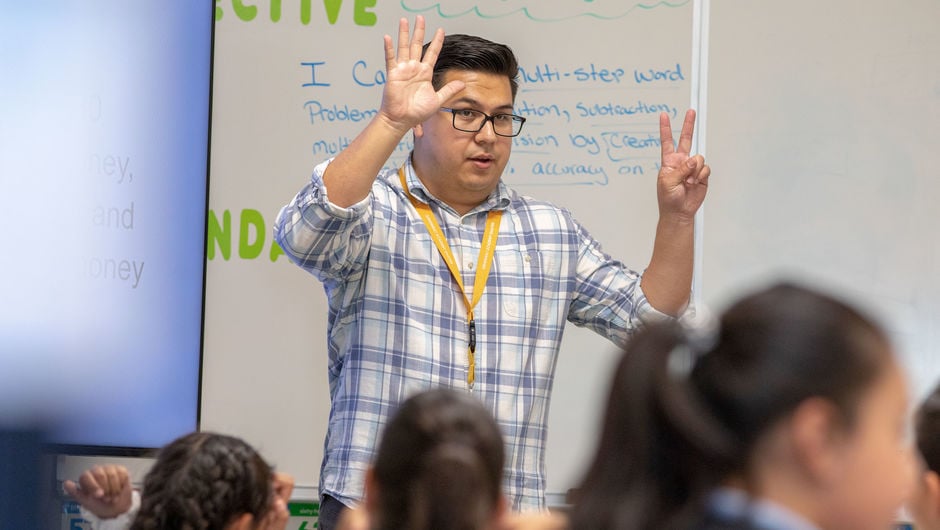
If students take time to smell, taste, and savor in food lab, they go at a fast pace in stem, reading and humanities. “We’re working on precision,” Kendrick says. Classes are inquiry-based, backed by robust assessments, “but a portion of every class is direct instruction: let’s hit it and get it.”
Fourth graders in Frank Pasillas’ class competed to see which group could solve the most math word problems by “rocking a model.”
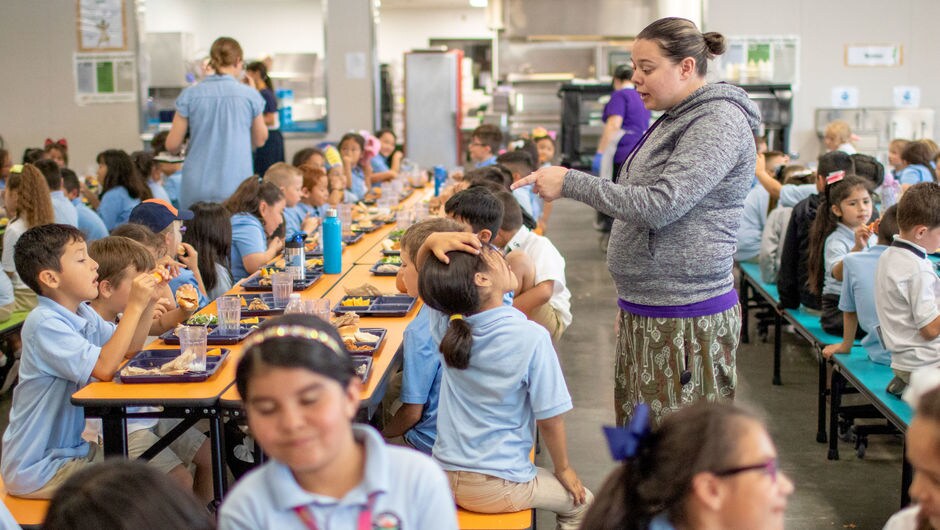
An irony is that in the nation’s biggest growing region, the school’s seven cooks can’t buy produce direct from farms in their county. Distributors won’t sell to such a small buyer. Head chef Anna Melby networks far and wide to source healthy ingredients the school can afford to purchase with federal school lunch funds. Protein is the most expensive, so she buys frozen “commodity” chicken on the bone.
Students are heavily encouraged to eat school lunch, but if they bring lunch it’s checked by a nurse for items that don’t meet wellness standards. Melby says kids need to try a food like asparagus multiple times before they enjoy it. Lick it if you don’t want to swallow it, she tells students, and tell your brother if you liked it.
Skeptical parents are invited to eat lunch with their kids. They’re on campus often anyway. To keep enrollment community-centered, the school provides no transportation, if you don’t count encouraging kids to arrive on razor scooters.
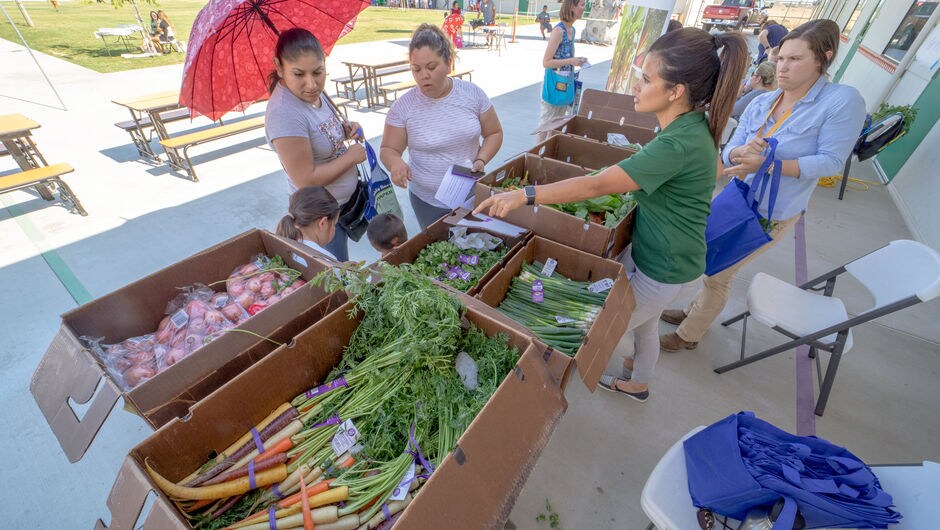
On a recent day, teachers and other school staff members organized an after-school expo for families to come and play, get their bikes fixed, and buy discounted organic produce from the grower that seeded the school through its foundation, and gave it the Grimmway name.
Sign up to receive articles like this in your inbox!
Thanks for signing up!
Content is loading...



